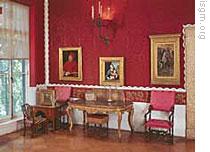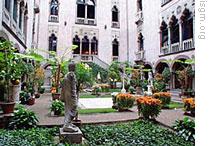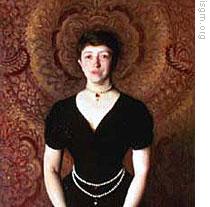VOA慢速英语 2009 0111a
搜索关注在线英语听力室公众号:tingroom,领取免费英语资料大礼包。
(单词翻译)
VOICE ONE:I'm Steve Ember.
VOICE TWO:
And I'm Barbara Klein with PEOPLE IN AMERICA in VOA Special English. Today we tell about the art collector and cultural supporter, Isabella Stewart Gardner.
During the late nineteenth century, she traveled around the world to learn about foreign cultures and improve her knowledge of art. Missus Gardner was a celebrated1 arts and community supporter in her hometown of Boston, Massachusetts. She spent her later years turning her home and art collection into a beautiful museum for the public to enjoy.
(MUSIC)
VOICE ONE:
The Isabella Stewart Gardner museum does not seem like a museum. It looks like what it is: a large, beautiful home built in the style of sixteenth century Italy. But this home contains over two thousand pieces of art organized from room to room by period and by geography.
VOICE TWO:
 |
| The Raphael Room |
The collection includes paintings, sculpture, rare books, jewelry2, and pieces of ancient buildings. For example, the Blue Room contains paintings by nineteenth century artists including Edouard Manet and Eugene Delacroix. It also contains finely made furniture and displays of letters from many famous American writers who were friends of Missus Gardner during her lifetime.
From this room, you can explore the nearby Chinese Loggia, or go upstairs to see the Italian art hung on the deep red walls of the Raphael Room.
VOICE ONE:
The four levels of rooms center on a beautiful courtyard with a glass ceiling to let light shine in. The art collection is organized in a way that is warm and personal. So you feel like you are a guest in a home instead of a visitor in a huge, impersonal3 museum.
This museum is one of a kind. It is the only private art collection in the United States that had one person design the building, the collection and the way in which the art is hung. Let us learn more about this interesting woman who devoted4 her life to art.
(MUSIC)
VOICE TWO:
Isabella Stewart was born in New York City in eighteen forty. Her father, David Stewart, made a great deal of money in the trade of linen5 cloth and iron. Isabella went to private schools in New York and in Paris, France, where her family lived for two years. During this time, her parents took her to Italy to explore the country's many cultural treasures.
VOICE ONE:
 |
| The courtyard |
One of the private art collections Isabella visited in Milan had a deep influence on her. She wrote to one of her friends about her dream of one day owning a house with an art collection like the one she had seen in Italy. Isabella said in the letter that she would fill the house with art and beautiful old furniture called antiques6 so that other people could enjoy them.
VOICE TWO:
In Paris, Isabella became close friends with one of her classmates, Julia Gardner, whose family was from Boston, Massachusetts. Julia would later introduce Isabella to her brother, Jack7. In eighteen sixty, Isabella Stewart married Jack Gardner. The couple moved to Boston.
VOICE ONE:
In eighteen sixty-three, Isabella gave birth to a son, Jackie, who died two years later. To help his wife overcome a severe depression, Jack Gardner planned for them to travel to Europe. The couple traveled through Norway, Russia, Austria and France. This change of environment helped Isabella Gardner greatly. She soon regained8 the sense of humor9 and spirit for which she was known.
VOICE TWO:
The couple traveled together often. One trip was to Egypt, Palestine, and Greece. Isabella kept detailed10 written descriptions of their travels. Her travel writing showed a sense of adventure and love of the art and traditions of other cultures. On another trip, she and her husband visited the art and monuments of Japan, Cambodia, Indonesia, and India.
In eighteen seventy-five, the Gardners adopted the three sons of Jack's brother, who had recently died.
(MUSIC)
VOICE ONE:
 |
| A portrait of Isabella Stewart Gardner by John Singer Sargent |
Isabella Stewart Gardner did not behave like most women of her time. She was very independent and not afraid to express her thoughts and opinions. She smoked cigarettes and hosted parties that were famous around town. She learned11 all she could about subjects that were important to her, such as art and literature. She also developed relationships with interesting people. She became good friends with the American painters John Singer Sargent and James McNeill Whistler and the writer Henry James. She collected the work of the great ancient painters, but also worked hard to support modern artists beginning their careers.
VOICE TWO:
Missus Gardner took a great interest in the community activities of Boston. She loved to attend Red Sox baseball games as well as other sports at nearby Harvard College. And, she gave financial support to organizations that supported animal rights and the planting of city gardens. Her independence and spirit caught the attention of the media. Reporters often wrote stories about her, some of which were more true than others. Missus Gardner did not seem to mind. She was known to have said: "Don't spoil12 a good story by telling the truth!"
VOICE ONE:
During her many travels, Isabella Gardner visited art galleries and consulted with art experts. She wanted to be fully13 educated about the art collection she was starting to build. When Isabella's father died in eighteen ninety-one, she used the money he left her to buy more art. A few years later, Isabella and Jack Gardner bought three major paintings by great artists. One was by the Dutch artist Rembrandt, another by the Spanish artist Velazquez, and another was by the Italian artist, Titian.
VOICE TWO:
The couple knew they now had too much art to fit inside their home. So they decided14 to start planning a museum. Missus Gardner decided that she did not like the cold and empty spaces of many museums during her time. She wanted to create a museum that was warm and filled with light. The building design of ancient homes in Venice, Italy, became the influence for their museum.
VOICE ONE:
Missus Gardner once said that she decided years ago that the greatest need in her country was art. She said America was a young country developing quickly in other areas. But the country needed more chances for people to see beautiful examples of art.
(MUSIC)
VOICE TWO:
In eighteen ninety-eight, Jack Gardner died unexpectedly15 of a stroke16. Isabella knew she had no time to lose in building her museum. She bought land, hired a building designer, and supervised17 every detail of her museum's construction. Around nineteen oh one, Missus Gardner moved into the fourth floor of the museum, where she would live for the rest of her life. For over a year, she worked on putting her art collection into place.
VOICE ONE:
Missus Gardner opened her museum on January first, nineteen oh three. The museum at this time was called Fenway Court. She invited her friends that night for a special musical performance by members of the Boston Symphony18 Orchestra19. One person attending that evening described how the perfection20 of all things in the museum seemed to have an unusual effect on the guests. He said its effect was very extraordinary and wonderful, like a miracle21.
The next month, she opened the museum to the public. At first, visits were limited to twenty days out of the year. Visitors paid one dollar to enter.
VOICE TWO:
Isabella Stewart Gardner died in nineteen twenty-four in Boston. In her will, she left the museum a million dollars and a series of requirements about how it should be managed. One requirement is that the permanent collection cannot be changed.
VOICE ONE:
But one major change was beyond the museum's control. In March of nineteen ninety, robbers22 dressed as police entered the museum and stole thirteen works23 of art. They stole some of the most valuable works in the collection. They included three paintings by Rembrandt and another by the Dutch master Johannes Vermeer. The paintings were never recovered. Empty frames24 hang on the walls were the paintings once were displayed as a reminder25 of this tragic26 crime.
VOICE TWO:
The Isabella Stewart Gardner Museum is as interesting today as it was one hundred years ago. But it also keeps up with today's community. The museum holds many events so that the public can enjoy musical evenings, educational programs and other activities. Modern artists can take part in the museum's artist-in-residence program. And, the museum invites public school students to view the collection while also providing teachers with art education projects.
The memory and spirit of Isabella Stewart Gardner lives on in the museum she created to share her love of art with the people.
(MUSIC)
VOICE ONE:
This program was written and produced by Dana Demange. I'm Steve Ember.
VOICE TWO:
And I'm Barbara Klein. You can learn about other famous Americans at our Web site, voaspecialenglish.com. Join us again next week for PEOPLE IN AMERICA in VOA Special English.
 收听单词发音
收听单词发音 




